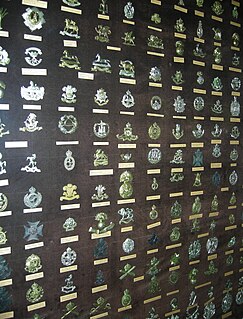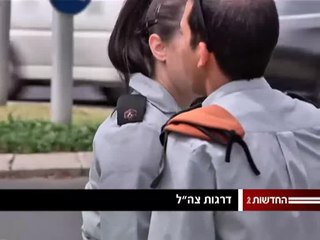
Sergeant is a rank in many uniformed organizations, principally military and policing forces. The alternative spelling, serjeant, is used in The Rifles and other units that draw their heritage from the British Light Infantry. Its origin is the Latin serviens, 'one who serves', through the French term sergent.
Corporal is a military rank in use in some form by many militaries and by some police forces or other uniformed organizations. Within NATO, each member nation's corresponding military rank of corporal is combined under the NATO-standard rank scale code OR-3 or OR-4. However, there are often differences in how each nation employs corporals. Some militaries don't have corporals, but may instead have a Junior Sergeant.
Staff sergeant is a rank of non-commissioned officer used in the armed forces of several countries. It is also a police rank in some police services.
Sergeant major is a senior non-commissioned rank or appointment in many militaries around the world. In Commonwealth countries, the various degrees of sergeant major are appointments held by warrant officers. In the United States, there are also various grades of sergeant major, all of the same pay grade of E-9; however, the Sergeant Major of the Army and the Sergeant Major of the Marine Corps, as their respective service's Senior Enlisted Advisor, receive a special rate of basic pay that is higher than all other sergeants major.
The chart below shows the current enlisted rank insignia of the United States Army, with seniority, and pay grade, increasing from right to left. Enlisted ranks of corporal and higher are considered non-commissioned officers (NCOs). The rank of specialist is a soldier of pay grade E-4 who has not yet attained non-commissioned officer status. It is common that a soldier may never be a corporal and will move directly from specialist to sergeant, attaining NCO status at that time.
Chief warrant officer is a military rank used by the United States Armed Forces, the Canadian Armed Forces, the Pakistan Air Force, the Israel Defense Forces, the South African National Defence Force, the Lebanese Armed Forces and, since 2012, the Singapore Armed Forces. In the United States Armed Forces, chief warrant officers are commissioned officers, not non-commissioned officers (NCOs) like in other NATO forces.

A cap badge, also known as head badge or hat badge, is a badge worn on uniform headgear and distinguishes the wearer's nationality and/or organisation. The wearing of cap badges is a convention commonly found among military and police forces, as well as uniformed civilian groups such as the Boy Scouts, civil defence organisations, ambulance services, customs services, fire services etc.
Officer cadet is a rank held by military cadets during their training to become commissioned officers. In the United Kingdom, the rank is also used by members of University Royal Naval Units, University Officer Training Corps and University Air Squadron however these are not trainee officers and most do not join the armed forces.

The term used to refer to all ranks below officers is "other ranks". It includes warrant officers, non-commissioned officers ("NCOs") and ordinary soldiers with the rank of private or regimental equivalent. Officers may, in speaking, distinguish themselves from those "in the ranks".
Most of the police forces of the United Kingdom use a standardised set of ranks, with a slight variation in the most senior ranks for the Metropolitan Police Service and City of London Police. Most of the British police ranks that exist today were chosen by Home Secretary Sir Robert Peel, the founder of the Metropolitan Police, enacted under the Metropolitan Police Act of 1829. The ranks at that time were deliberately chosen so that they did not correspond with military ranking, because of fears of a paramilitary force.
Finnish military ranks form a system that incorporates features from Swedish, German, and Russian armed forces. In addition, the system has some typically Finnish characteristics that are mostly due to the personnel structure of the Finnish Defence Forces. The ranks have official names in Finnish and Swedish languages and official English translations. The Swedish forms are used in all Swedish-languages communications in Finland, e.g. in Swedish-speaking units of Finnish Defence Force. The system of ranks in the Swedish Armed Forces is slightly different.
Before Unification as the Canadian Armed Forces in 1968, the Canadian military had three distinct services: the Royal Canadian Navy, the Royal Canadian Air Force, and the Canadian Army. All three services had a Regular (full-time) component and a reserve (part-time) component. The rank structure for these services were based on the services of the British military, the Royal Navy, the Royal Air Force, and the British Army. The change to a "Canadian" rank structure meant that many of the traditional (British) rank titles and insignia were removed or changed.

The Israeli Defense Forces (IDF) has a unique rank structure. Because the IDF is an integrated force, ranks are the same in all services The ranks are derived from those used in the pre-state paramilitary Haganah, which operated during the Mandate period in order to protect the Yishuv. This is reflected in the slightly compacted rank structure: for instance, the Chief of Staff is seemingly only equivalent to a lieutenant general in other militaries.
St John Ambulance Ireland (SJAI), previously known as the St John Ambulance Brigade of Ireland, is a charitable voluntary organisation in Ireland. For constitutional reasons it is not a full member association of the Venerable Order of Saint John and the international St. John Ambulance movement, but rather is classed as an "associated body". The organisation is dedicated to the teaching and practice of medical first aid. It is engaged in first aid training to the public, providing first aid and ambulance cover at public events, patient transport and community services.
The Italian Army ranks are the ranks used by the Italian Army and are worn on epaulettes of shirts. The Army of Italy contains levels of ranks showing both their officers' status and seniority as dedicated members of the Italian militia. Although altered throughout history, the current ranks stand as the lowest rank being "soldato semplice" and the highest rank being "generale". There are a total of 32 ranks within 7 categories. These categories include: temporary service volunteers, permanent service volunteers, sergeants, marshals (NCOs), junior officers, senior officers, and generals.

A warrant officer (WO) in the British Armed Forces is a member of the highest group of non-commissioned ranks, holding the Queen's warrant, which is signed by the Secretary of State for Defence. Warrant officers are not saluted as they do not hold the Queen's Commission, however they are to be addressed as 'Sir/Ma'am' by subordinates. Commissioned officers may address warrant officers either by their appointment or as "Mister", "Mrs", or "Ms" and then their last name, e.g. "Mr Smith". Although often referred to along with non-commissioned officers (NCOs), they are not NCOs, but members of a separate group, although all have been promoted from NCO rank.
This article deals with the rank insignia of the Austro-Hungarian armed forces, as worn by the Austro-Hungarian Army after the reorganisation in 1867 until 1918.
The following table displays the ranks of the Community Cadet Forces, the Combined Cadet Force, the Volunteer Cadet Corps, and the Girls Venture Corps Air Cadets. This table is based on equivalent Rank Structures within the Cadet Forces as detailed in regulations of the SCC, RMC, and the Air Cadets.




















